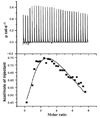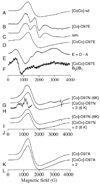Analyzing the catalytic role of Asp97 in the methionine aminopeptidase from Escherichia coli
- PMID: 19019076
- PMCID: PMC2699115
- DOI: 10.1111/j.1742-4658.2008.06749.x
Analyzing the catalytic role of Asp97 in the methionine aminopeptidase from Escherichia coli
Abstract
An active site aspartate residue, Asp97, in the methionine aminopeptidase (MetAPs) from Escherichia coli (EcMetAP-I) was mutated to alanine, glutamate, and asparagine. Asp97 is the lone carboxylate residue bound to the crystallographically determined second metal-binding site in EcMetAP-I. These mutant EcMetAP-I enzymes have been kinetically and spectroscopically characterized. Inductively coupled plasma-atomic emission spectroscopy analysis revealed that 1.0 +/- 0.1 equivalents of cobalt were associated with each of the Asp97-mutated EcMetAP-Is. The effect on activity after altering Asp97 to alanine, glutamate or asparagine is, in general, due to a approximately 9000-fold decrease in k(ca) towards Met-Gly-Met-Met as compared to the wild-type enzyme. The Co(II) d-d spectra for wild-type, D97E and D97A EcMetAP-I exhibited very little difference in form, in each case, between the monocobalt(II) and dicobalt(II) EcMetAP-I, and only a doubling of intensity was observed upon addition of a second Co(II) ion. In contrast, the electronic absorption spectra of [Co_(D97N EcMetAP-I)] and [CoCo(D97N EcMetAP-I)] were distinct, as were the EPR spectra. On the basis of the observed molar absorptivities, the Co(II) ions binding to the D97E, D97A and D97N EcMetAP-I active sites are pentacoordinate. Combination of these data suggests that mutating the only nonbridging ligand in the second divalent metal-binding site in MetAPs to an alanine, which effectively removes the ability of the enzyme to form a dinuclear site, provides a MetAP enzyme that retains catalytic activity, albeit at extremely low levels. Although mononuclear MetAPs are active, the physiologically relevant form of the enzyme is probably dinuclear, given that the majority of the data reported to date are consistent with weak cooperative binding.
Figures






Similar articles
-
Kinetic and spectroscopic analysis of the catalytic role of H79 in the methionine aminopeptidase from Escherichia coli.Biochemistry. 2008 Nov 11;47(45):11885-93. doi: 10.1021/bi801499g. Epub 2008 Oct 15. Biochemistry. 2008. PMID: 18855426 Free PMC article.
-
Kinetic and spectroscopic characterization of the H178A methionyl aminopeptidase from Escherichia coli.Biochemistry. 2003 May 27;42(20):6283-92. doi: 10.1021/bi027327s. Biochemistry. 2003. PMID: 12755633
-
EPR and X-ray crystallographic characterization of the product-bound form of the MnII-loaded methionyl aminopeptidase from Pyrococcus furiosus.Biochemistry. 2005 Jan 11;44(1):121-9. doi: 10.1021/bi048123+. Biochemistry. 2005. PMID: 15628852
-
Structure and function of the methionine aminopeptidases.Biochim Biophys Acta. 2000 Mar 7;1477(1-2):157-67. doi: 10.1016/s0167-4838(99)00271-x. Biochim Biophys Acta. 2000. PMID: 10708856 Review.
-
Methionine as translation start signal: a review of the enzymes of the pathway in Escherichia coli.Biochimie. 1993;75(12):1061-75. doi: 10.1016/0300-9084(93)90005-d. Biochimie. 1993. PMID: 8199241 Review.
Cited by
-
Self-subunit swapping occurs in another gene type of cobalt nitrile hydratase.PLoS One. 2012;7(11):e50829. doi: 10.1371/journal.pone.0050829. Epub 2012 Nov 30. PLoS One. 2012. PMID: 23226397 Free PMC article.
-
Metallo-aminopeptidase inhibitors.Biochimie. 2010 Nov;92(11):1509-29. doi: 10.1016/j.biochi.2010.04.026. Epub 2010 May 10. Biochimie. 2010. PMID: 20457213 Free PMC article. Review.
References
-
- Bradshaw RA. Protein translocation and turnover in eukaryotic cells. TIBS. 1989;14:276–279. - PubMed
-
- Meinnel T, Mechulam Y, Blanquet S. Methionine as translation start signal – a review of the enzymes of the pathway in Escherichia coli. Biochimie. 1993;75:1061–1075. - PubMed
-
- Bradshaw RA, Brickey WW, Walker KW. N-terminal processing: the methionine aminopeptidase and Nα-acetyl transferase families. TIBS. 1998;23:263–267. - PubMed
-
- Arfin SM, Bradshaw RA. Cotranslational processing and protein turnover in eukaryotic cells. Biochemistry. 1988;27:7979–7984. - PubMed
-
- Lowther WT, Matthews BW. Metalloamino-peptidases: common functional themes in disparate structural surroundings. Chem Rev. 2002;102:4581–4607. - PubMed
Publication types
MeSH terms
Substances
Grants and funding
LinkOut - more resources
Full Text Sources
Molecular Biology Databases
Miscellaneous

